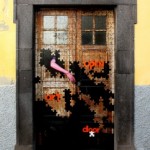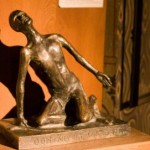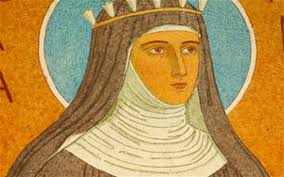 We cannot live in a world that is interpreted for us by others. An interpreted world is not a hope. Part of the terror is to take back our own listening. To use our own voice. To see our own light. – Hildegard of Bingen, quoted by Barbara Brown Taylor, in Learning to Walk in the Dark.
We cannot live in a world that is interpreted for us by others. An interpreted world is not a hope. Part of the terror is to take back our own listening. To use our own voice. To see our own light. – Hildegard of Bingen, quoted by Barbara Brown Taylor, in Learning to Walk in the Dark.
Saints are luminous. In our iconography, they wear haloes. And in our story-telling, they shed light upon the world around them, and the light they shed reveals God.
They have long been suspect, though, among Protestants, whose Reformers preferred to lift into the light the lives of ordinary folks, and call them Holy, and People of God. New England, especially, has been anti-heroic in its religion. Congregationalists had no Main Man, no Founding Father, no doctrinal yardstick by which to measure lives, ideas.
A pastiche, a quilt, a stew of theologies form the platform for holiness, and the ingredients change 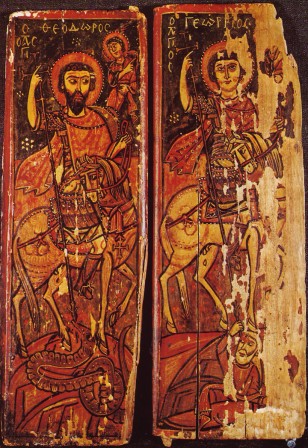 often, as the schools and the preachers themselves change. A dash of Luther, a dollop of Cranmer, a pinch of Calvin, a cupful of Renaissance humanism, an equal amount of Celtic nature devotion, an adoration of the printed word, all these remain in the blend now, and have been there since the earliest preachers stepped ashore. Yet there is no doffing of the cap to any of them in particular, rather a continued wrestling with them all. And the flavor of the age is in there, too: perhaps a Beecher, or a William Sloane Coffin, or the Dalai Lama, or the Beatles.
often, as the schools and the preachers themselves change. A dash of Luther, a dollop of Cranmer, a pinch of Calvin, a cupful of Renaissance humanism, an equal amount of Celtic nature devotion, an adoration of the printed word, all these remain in the blend now, and have been there since the earliest preachers stepped ashore. Yet there is no doffing of the cap to any of them in particular, rather a continued wrestling with them all. And the flavor of the age is in there, too: perhaps a Beecher, or a William Sloane Coffin, or the Dalai Lama, or the Beatles.
Yet for all our piety of ordinariness, the idolatry of heroism does creep in. The calendar of saints in liturgical churches is made from lives as ordinary and faithful and human as any reformer could want. Yet time and the imagination of our hearts transforms them into paragons of achievement. And in the non-liturgical churches we do the same.
Jesus, though, lifted up the lives of those from whom we’d rather look away: the lost, the lame, the lonely, the lovelorn, the left-behind. A blind beggar from the streets of Jericho. A Samaritan who helped a beaten man. A father with two troublesome sons and a weary heart. A woman bent-over for eighteen years. Another with twelve demons in her spirit. Peter, the fool, who loved Jesus and almost never understood him.
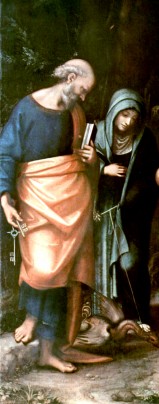 Jesus never climbed the ladder of success. In fact, he warned against even a step-stool of status in the preaching of the kingdom. Don’t take special names of honor for yourself, he said to the disciples, and don’t call anyone Father, for only God gives you life, and deserves that honor.
Jesus never climbed the ladder of success. In fact, he warned against even a step-stool of status in the preaching of the kingdom. Don’t take special names of honor for yourself, he said to the disciples, and don’t call anyone Father, for only God gives you life, and deserves that honor.
We do, though. We use Reverend, and Pastor, and Friend with a capital. When I was a child, we had a minister who had us call him Pa! And he called everyone Dearie.
Jesus pronounced us Blessed, not when we were achieving things, and not when our lives were going splendidly, not on graduation days and not when we paid off the mortgage, but when we were lost and lonely and loveless:
Blessed are you, he said, when you are poor in spirit; when you are laid low by mourning; when you are meek, and unheard; when you long for justice with all your heart; when you are merciful; when your heart is pure enough to see the good in people; when you are peacemakers; when you are persecuted and when you are reviled. For, he said, the kingdom of heaven is yours. You shall be comforted and your hearts shall lift up. Your hunger for justice shall be filled. You shall see God with your pure heart. And enter the kingdom in your peacemaking. And be alive with me, for I, too was persecuted and reviled, as were the prophets.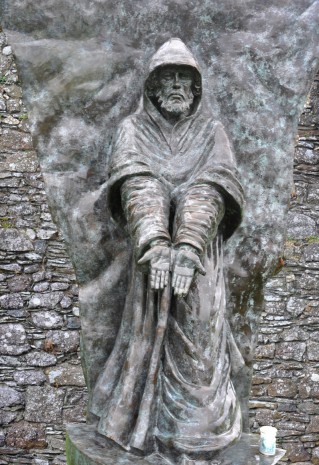
Jesus treasures in those who hurt so, their ability to survive with their own humanity intact despite the way they have been treated by the world. This part of themselves becomes a shining light, becomes the window of their souls, and a lighted path for all our souls.
And by choosing no others to hold up to us than these, who have been despised and for long, Jesus is teaching that Saints do not come into this world apart from their suffering.
Nor will we be able to find the light of God in our own lives, apart from ours. For the saints are not among us to show us the way into easy, comfortable lives. They are here to show us how to keep going in deep darkness, how to survive the bullies, how to have hope in mean times.
 It is November. The spooks and hobgoblins, the ghouls and ghosts, are abroad in the dark of the year. And so are the Saints, whose cauldrons are full of the tastes of their adventures, and the fire of their spirits, and the light that they have seen in this world, with the eyes of their hearts.
It is November. The spooks and hobgoblins, the ghouls and ghosts, are abroad in the dark of the year. And so are the Saints, whose cauldrons are full of the tastes of their adventures, and the fire of their spirits, and the light that they have seen in this world, with the eyes of their hearts.
_______________________________________
Illustrations:
1. Contemporary Icon, Hildegard of Bingen. Google Images.
2. St. George Sinai, doors, St. Catherine’s-Monastery-9th-c. Vanderbilt Divinity School Library, Art in the Christian Tradition.
3. Two Saints: Peter and Martha. Caravaggio, 1517. Metropolitan Museum of Art, New York. Vanderbilt Divinity School Library, Art in the Christian Tradition.
4. St. Brendan. Freestanding Sculpture, Knock, County Mayo. Ireland. Vanderbilt Divinity School Library, Art in the Christian Tradition.
6. Disciples John and Peter walking on the beach. Burnand, Eugène. 1898. Musee-D’Orsay, Paris. Vanderbilt Divinity School Library, Art in the Christian Tradition.



